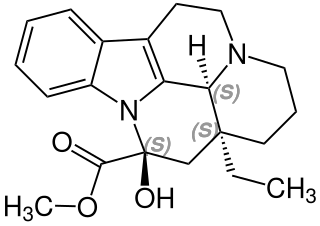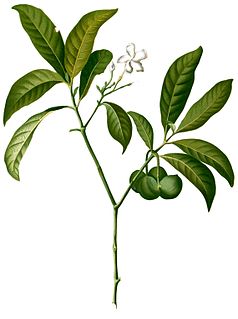
Apocynaceae is a family of flowering plants that includes trees, shrubs, herbs, stem succulents, and vines, commonly known as the dogbane family, because some taxa were used as dog poison. Members of the family are native to the European, Asian, African, Australian, and American tropics or subtropics, with some temperate members. The former family Asclepiadaceae is considered a subfamily of Apocynaceae and contains 348 genera. A list of Apocynaceae genera may be found here.

Ibogaine is a naturally occurring psychoactive substance found in plants in the family Apocynaceae such as Tabernanthe iboga, Voacanga africana, and Tabernaemontana undulata. It is a psychedelic with dissociative properties.
Cyclostigma is a genus of extinct plants belonging to the Lycopodiopsida (lycopsids).

Louis-Marie Aubert du Petit-Thouars was an eminent French botanist known for his work collecting and describing orchids from the three islands of Madagascar, Mauritius and Réunion. The standard author abbreviation Thouars is used to indicate this person as the author when citing a botanical name.

Voacangine is an alkaloid found predominantly in the root bark of the Voacanga africana tree, as well as in other plants such as Tabernanthe iboga, Tabernaemontana africana, Trachelospermum jasminoides, Tabernaemontana divaricata and Ervatamia yunnanensis. It is an iboga alkaloid which commonly serves as a precursor for the semi-synthesis of ibogaine. It has been demonstrated in animals to have similar anti-addictive properties to ibogaine itself. It also potentiates the effects of barbiturates. Under UV-A and UV-B light its crystals fluoresce blue-green, and it is soluble in ethanol.

Vincamine is a monoterpenoid indole alkaloid found in the leaves of Vinca minor, comprising about 25-65% of its indole alkaloids by weight. It can also be synthesized from related alkaloids.

Voacanga africana is a small tree native to tropical Africa belonging to the family Apocynaceae that grows to 6 m (20 ft) in height and bears leaves that are up to 30 cm (12 in) in length. The yellow or white flowers are succeeded by paired, follicular, dehiscent fruit with a mottled green exocarp and a pulpy, yellow mesocarp surrounding the seeds. The plant contains alkaloids acting as CNS depressants and hypotensives
V. africana may refer to:

Voacamine, also known under the older names voacanginine and vocamine, is a naturally occurring dimeric indole alkaloid of the secologanin type, found in a number of plants, including Voacanga africana and Tabernaemontana divaricata.

Rauvolfioideae is a subfamily of the flowering plant family Apocynaceae. Many species are woody lianas, others are shrubs or perennial herbs.

Voacanga is a genus of plants in the family Apocynaceae found in Africa, Southeast Asia, New Guinea, and Australia. As of August 2013 the World Checklist of Selected Plant Families recognises 13 species:
- Voacanga africanaStapf ex Scott-Elliot - tropical W + C + E + S Africa
- Voacanga bracteataStapf - tropical W + C Africa
- Voacanga caudifloraStapf - tropical W Africa
- Voacanga chalotianaPierre ex Stapf - tropical C Africa
- Voacanga foetida(Blume) Rolfe -Java, Borneo, Sumatra, Philippines
- Voacanga globosa(Blanco) Merr. - Philippines
- Voacanga gracilipes(Miq.) Markgr. - Maluku
- Voacanga grandifolia(Miq.) Rolfe - Indonesia, Philippines, New Guinea, Queensland
- Voacanga havilandiiRidl. - Sarawak
- Voacanga megacarpaMerr. - Philippines
- Voacanga pachycerasLeeuwenb. - Zaïre
- Voacanga psilocalyxPierre ex Stapf - Nigeria, Cameroon, Gabon, Republic of Congo
- Voacanga thouarsiiRoem. & Schult. Madagascar; widespread from Cape Province to Sudan + Senegal
- Voacanga dichotoma = Tabernaemontana pachysiphon
- Voacanga plumeriifolia = Tabernaemontana macrocarpa

Voacanga thouarsii, the wild frangipani, is a species of small tree in the family Apocynaceae.
Voacanga foetida grows as a tree up to 20 metres (70 ft) high, with a trunk diameter of up to 40 centimetres (16 in). The bark is grey, whitish brown or grey-brown. Its unpleasant-smelling flowers feature a white corolla. Fruit is up to 11 cm (4 in) in diameter. The specific epithet foetida is from the Latin meaning "evil-smelling". Habitat is forest from sea-level to 600 metres (2,000 ft) altitude. V. foetida is found in Indonesia, Malaysia and the Philippines.
Voacanga havilandii grows as a small tree up to 15 metres (50 ft) high, with a trunk diameter of up to 15 centimetres (6 in). The bark is pale green to whitish. Its flowers feature a white or cream corolla. The fruit is up to 5 cm (2 in) in diameter. Its habitat is lowland forest from sea level to 200 metres (700 ft) altitude. V. havilandii is endemic to Borneo.

Tabersonine is a terpene indole alkaloid found in the medicinal plant Catharanthus roseus and also in the genus Voacanga. Tabersonine is hydroxylated at the 16 position by the enzyme tabersonine 16-hydroxylase (T16H) to form 16-hydroxytabersonine. The enzyme leading to its formation is currently unknown. Tabersonine is the first intermediate leading to the formation of vindoline one of the two precursors required for vinblastine biosynthesis.

Omo Forest Reserve is a preserved area of tropical rainforest in the Nigerian state of Ogun, in the south-west part of the country. It is located about 135 km (84 mi) northeast of Lagos and 80 km (50 mi) east of Ijebu Ode. This nature reserve covers an area of 130,500 hectares. The average rainfall is around 2,000 mm (80 in). The terrain is largely flat and well-drained, with some low rolling hills, and forms part of the Omo River watershed.

Dregamine is a naturally occurring monoterpene indole alkaloid found in several species in the genus Tabernaemontana including Ervatamia hirta and Tabernaemontana divaricata.

Vobasine is a naturally occurring monoterpene indole alkaloid found in several species in the genus Tabernaemontana including Tabernaemontana divaricata.

Voacristine is a alkaloid occurring in Voacanga africana and Tabernaemontana divaricata. When it is degraded, iboxygaine and ibogaine are formed.
Voacanga grandifolia also known as Voacanga papuana is a plant found in many countries including Papua New Guinea.















